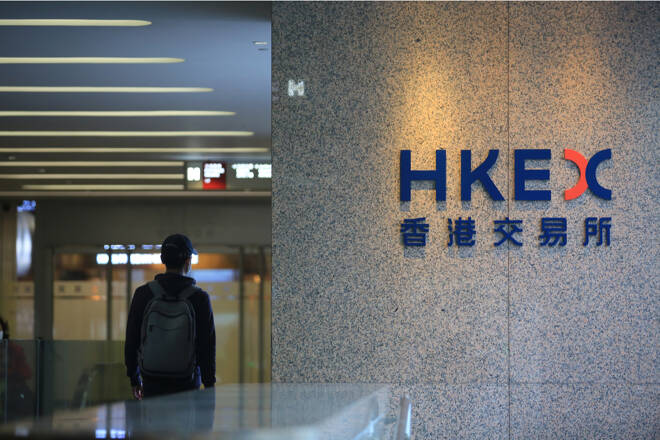Advertisement
Advertisement
Hang Seng Index Dips as US Treasury Yields Surge, China Stimulus Awaited
By:
Key Points:
- Hang Seng Index slips 0.14% as Chinese real estate and tech stocks decline, awaiting potential stimulus from Beijing.
- Nikkei rises 0.20%, bolstered by USD/JPY rally as Japan's private sector PMI raises doubts over a BoJ rate hike.
- ASX 200 gains 0.19% with banking stocks leading the advance, but mining stocks fall on lower iron ore prices and Fortescue updates.
US Markets Slide as Treasury Yields Hit 3-Month High
On Wednesday, October 23, US equity markets ended the session in negative territory. The Nasdaq Composite Index reversed its gains from Tuesday, sliding by 1.60%. The Dow and the S&P 500 also saw red, declining by 0.95% and 0.92%, respectively.
In the bond markets, 10-year US Treasury yields advanced to a 3-month intraday high of 4.260%, impacting demand for riskier assets. Yields climbed amid shifting sentiment toward the Fed rate path, uncertainty about the US Presidential Election, and mixed earnings.
Notably, McDonalds (MCD) slid by 5.12%, while Tesla (TSLA) rallied 12.10% in after-hours trading on earnings results.
The overnight losses from the US session set the tone for the Thursday Asian session.
Expert Views on the Fed Rate Path
Jurrien Timmer, Director of Global Macro at Fidelity, remarked on Wednesday’s US session, stating,
“The market and the Fed seem to be on the same page in terms of expecting only a moderate pace of rate cuts into the end of this year and for 2025. It’s really just a normalization of the restrictive policy stance, rather than a full easing cycle. I still think that 3.5-4.0% is a reasonable target zone for a soft landing.”
Private Sector PMIs Tests Bank of Japan Rate Hike Bets
On Thursday, October 24, private sector PMI numbers from Japan likely influenced bets on a Q4 2024 Bank of Japan rate hike. The crucial Jibun Bank Services PMI fell from 53.1 in September to 49.3 in October. Accounting for over 70% of Japan’s GDP, the October contraction aligns with Prime Minister Shigeru Ishiba view that the country is not ready for more rate hikes.
In September, Bank of Japan Governor Kazuo Ueda highlighted October’s Services PMI data, stating,
“October is a month when service price revisions are concentrated in Japan, so we must scrutinize data carefully.”
Despite rising input prices, the BoJ may delay rate hikes amid a contracting private sector.
Hang Seng Index and Mainland China Stocks See Red
Turning to the Asian equity markets, the Hang Seng Index dipped by 0.14% on Thursday morning. Real estate and tech stocks led the Index into negative territory. Higher 10-year US Treasury yields weighed on sentiment as investors awaited further stimulus measures from Beijing.
The Hang Seng Mainland Properties Index slid by 2.08%, while the Hang Seng Tech Index declined by 0.78%. Notable tech stock movers included Baidu (9888) and Alibaba (9988), which fell 2.14% and 3.19%, respectively.
Mainland China’s equity markets also saw morning losses, with the CSI 300 and Shanghai Composite seeing declines of 0.84% and 0.68%, respectively.
Nikkei Climbs as USD/JPY Briefly Hits 153
Meanwhile, the Nikkei Index advanced by 0.20% on Thursday morning. On Wednesday, October 23, the USD/JPY pair rallied 1.11% to end the session at 142.747, supporting demand for Nikkei-listed stocks.
Tokyo Electron (8035) gained 1.71%, while Sony Corp. (6758) was up 0.17%.
ASX 200 Ignores US Session Woes
In contrast to the US session woes, the ASX 200 Index gained 0.19% on Thursday morning. Banking stocks led the gains, while gold, mining, and tech-related stocks saw losses, capping the morning gains.
Commonwealth Bank of Australia (CBA) and ANZ (ANZ) rallied 1.18% and 1.40%, respectively.
However, Fortescue Metals Group (FMG) slid by 3.67% on disappointing iron ore shipments. Mining giants stocks BHP Group Ltd (BHP) and Rio Tinto Ltd (RIO) saw declines of 0.71% and 0.84%, respectively. Iron ore spot prices declined by 0.46%, dampening sentiment.
Looking Ahead
Investors should remain alert. Amidst the mixed performances across markets, fiscal stimulus from China and central bank commentary could affect market risk appetite. However, US Treasury yields and US futures also require consideration as investors consider upcoming US labor market data and private sector PMI figures.
About the Author
Bob Masonauthor
With over 28 years of experience in the financial industry, Bob has worked with various global rating agencies and multinational banks. Currently he is covering currencies, commodities, alternative asset classes and global equities, focusing mostly on European and Asian markets.
Did you find this article useful?
Latest news and analysis
Advertisement
